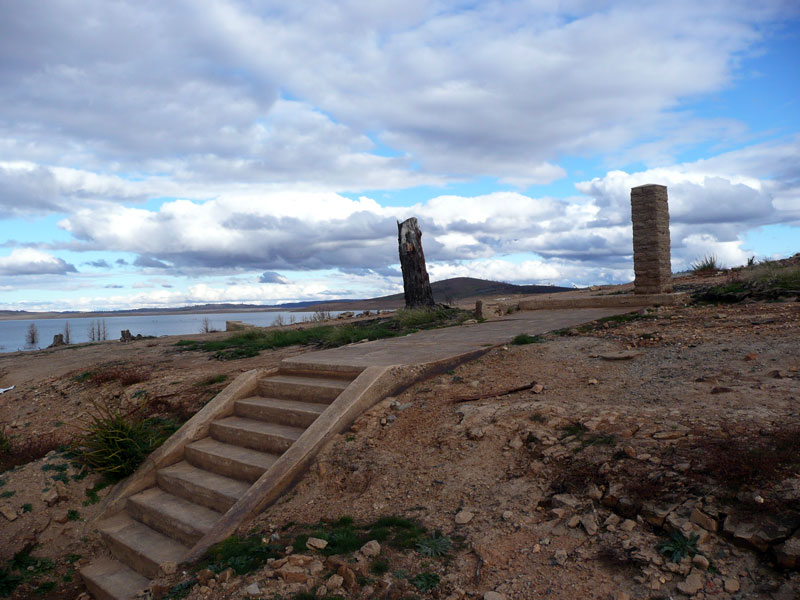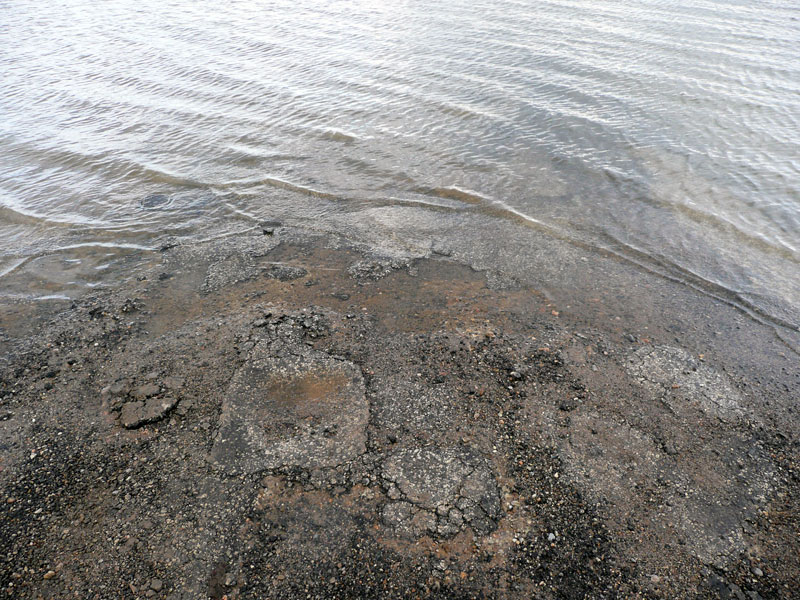Australia’s drought exposes ‘drowned town’
The legacies of a ‘tranquil’ flood and the Genesis Flood are very different

In the grip of drought, many of Australia’s major water storages have fallen to unprecedented lows.

For example, Lake Eucumbene in the Snowy Mountains is down to less than 20% of capacity—the lowest ever since that man-made lake was formed when the valley was dammed in 1958 as part of a large hydro-electricity scheme. One measure of the severity of the current drought is that the water level in Lake Eucumbene is now so low that the site of the former settlement of Adaminaby, which was never expected to be seen again after being submerged almost fifty years ago, is accessible once more. In fact, the sloping main street of the old town is now being used by locals as a boat ramp to access the depleted Lake Eucumbene.
‘We couldn’t believe it when the old streets started to reappear,’ said one former resident, Leigh Stewart, who grew up in old Adaminaby and once ran a shop there.1 He was one of about 700 residents of the former settlement (often referred to as ‘old Adaminaby’), which was compulsorily relocated by the government in the 1950s before the land was inundated.
More than 100 buildings from the old town were moved nine kilometres over a hill to the town that now bears the name Adaminaby.2 (Some timber houses were simply lifted onto the back of trucks and transported to the new town site; others such as St John’s Church of England were dismantled stone-by-stone and rebuilt.) About one-third of the old town’s residents chose to live in ‘new’ Adaminaby—the remainder took their compensation packages and moved elsewhere.



Rusted batteries, shards of pottery, bottles and other remnants of everyday life in the former settlement are now drying in the sunlight, exposed to the air for the first time in nearly half a century. One can see the foundations of old houses, covered by a layer of muddy silt. And the blackened skeletons of trees lining a road in old Adaminaby reach skyward out of the receding water—mute reminders of a town that was once a ‘thriving regional hub’ to which people travelled from surrounding districts to transact business.
According to media reports, the sight of the remnants of the once-familiar landmarks of the old town had been ‘stirring painful memories for former residents’.
Wandering down the streets where he played as a child, Greg Russell, now 82, could see once more the flight of concrete steps leading up to the site of the church where he was married. It was at the top of these steps that he and his wife Mary were sprinkled with confetti 60 years ago.
‘It’s sad and it makes me a bit nostalgic,’ he said. ‘We had some good times there and it’s strange to see it this way now.’
The Genesis Flood vs the Adaminaby experience

Might Noah, as he came off the Ark after the Genesis Flood, have felt similarly ‘sad and nostalgic’?

Actually, the Bible’s account of that event (Genesis 6–9) doesn’t say. But it’s notable that there’s not even the remotest hint that Noah and his family encountered any familiar landmark after the Flood. And, logically, that’s hardly surprising considering the vastly different scenario facing Noah compared to ‘old Adaminaby’ residents.
Firstly, there’s no indication that Noah saw where he once lived. In contrast to Adaminaby residents, Noah was not a land-based observer of the Genesis Flood, but floating on water—not a local body of water hemmed in by mountains, but water that covered the then highest mountains (Genesis 7:19).
Consequently the Ark was free to drift anywhere around the entire planet, far away from its starting point. Given the likely strong currents (note ‘fountains of the deep’ in Genesis 7:11) and wind (Genesis 8:1) the Ark could well have been borne thousands of kilometres during its five months afloat (Genesis 7:11; 8:4).
So, unlike Adaminaby residents once more treading the same latitude/longitude coordinates where they’d grown up, when Noah came off the Ark ‘in the mountains of Ararat’ (Genesis 8:4) he was probably at a point of the globe he’d never trodden before.
Secondly, the Genesis Flood’s water flows were catastrophic. In stark contrast to the slow filling of Lake Eucumbene,3 the Genesis Floodwaters came in a rush, with the ‘fountains of the great deep’ breaking open (Genesis 7:11), and ‘forty days and forty nights’ of continuous rain (Genesis 7:12). And though the volume of water in Lake Eucumbene (when at full capacity) is relatively large, it is as nothing compared to the Genesis Flood—an event where there was so much water it completely, and rapidly, inundated the entire planet, submerging the tops of the then highest mountains for 150 days (Genesis 7:19–20).

The violence of this event was such that every land animal and bird outside the Ark perished (Genesis 7:21–23), whereas there’s no indication of any such creatures drowning as the waters of Lake Eucumbene rose after the dam was completed in 1958. The very existence of fossils in sedimentary rock worldwide is consistent with the global Flood—creatures had to be buried quickly to be fossilized, and we find layer upon layer of sediment, obviously laid down in one hit.


Contrast Adaminaby’s meagre ‘layer of muddy silt’ and drowned trees still rooted in their original roadside positions with polystrate fossils—often very large tree trunks, ripped away from where they once grew, buried vertically straddling multiple sedimentary layers, many metres deep. (See The Yellowstone petrified forest.) Such huge quantities of sediment, violently shifted by rushing, planet-inundating water, testify to the dramatic re-shaping of the earth’s topography while Noah was aboard the Ark. The pre-Flood land trodden by Noah could have been literally ‘washed away’ or buried under hundreds of metres of sediment eroded from elsewhere. Little wonder that there’s no mention in the Bible, after the Flood, of Noah nostalgically ‘wandering again the streets where he played as a child’!4
Insights from Adaminaby
1. Comparing the legacy of the gentle flooding of Adaminaby with that from the catastrophic world-wide global Flood of Noah’s day shows that the Genesis Flood was definitely not ‘tranquil’ (nor local). In other words, the ‘tranquil flood’ theory, erroneously mooted by some, does not fit reality (see, e.g., Church leader aghast at belief in a worldwide Flood?, and Revisiting a worthless explanation).
2. We have pointed out elsewhere that the apparent lack of any human fossils or artifacts from pre-Flood civilizations might have been part of the fulfilment of the judgment given in Genesis 6:7, in which God said he would ‘blot out’ man from the face of the earth.

The Adaminaby flood, which left numerous artifacts and landmarks which ‘stirred painful memories’ for old-time residents, gives us another possible insight into why—i.e. to spare Noah and his family from the trauma of finding the remains of people/places they once knew. Such an ‘act of mercy’ towards Noah and his family is entirely consistent with a God of Mercy (Deuteronomy 4:31; Nehemiah 9:31; Luke 6:36; Romans 11:32). A God Who, in His mercy, promised to never again submerge the earth under water, despite the evil intent of man’s heart (Genesis 8:21, 9:9–17).
References
- Sands, N., Drought uncovers drowned town, NEWS.com.au, <www.smh.com.au/world/drought-uncovers-australias-drowned-town-20070419-8ag.html>, 27 April 2007. Return to Text
- Snowy Mountains Scheme, <www.naa.gov.au/home/snowy-mountains-hydro-electric-scheme>, 16 May 2007. Return to Text
- From normal seasonal rain/snow falling in the upper Eucumbene catchment, supplemented after 1960 by waters diverted via a tunnel from Tantangara Reservoir in the Murrumbidgee catchment. Return to Text
- A similar fate would have befallen Eden, pointing to the futility of trying to identify its location on the planet today. It also explains why the cherubim/flaming sword are no longer needed to guard the way to the ‘tree of life’ (Genesis 3:24)—the Flood put paid to any hopes of ever going back. (But see Revelation 22:2.) Return to Text

Readers’ comments
Comments are automatically closed 14 days after publication.